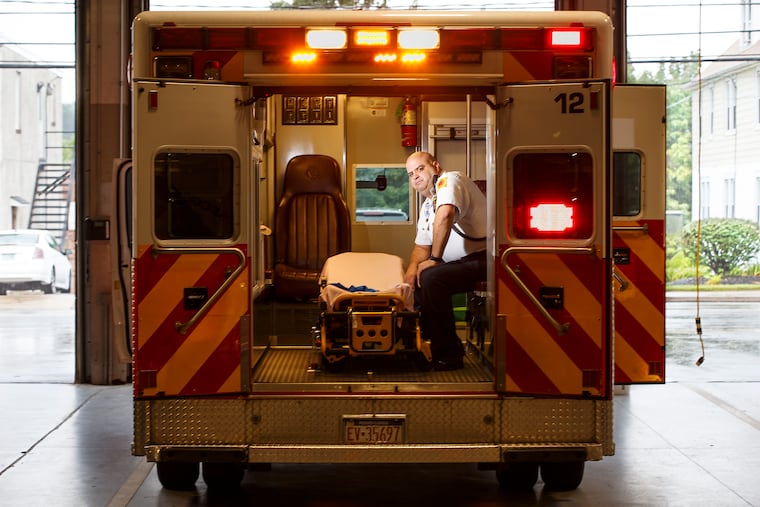Worried about ambulance costs? Consider a subscription.
Ambulance companies, especially those that respond to emergencies, are commonly not part of insurance networks and can bill patients for the remainder of their fee not paid by insurance. Ambulance memberships can offer reprieve.

Sandy Burdsall has Type 2 diabetes, so she is no stranger to high medical bills.
But ambulance fees are one kind of bill Burdsall never worries about — even though the service is often not covered in full by insurance and can cost patients thousands out of pocket.
Burdsall and her husband, who live in Southampton, are members of their local ambulance company, TriHampton Ambulance Squad.
For their $100 annual donation to the squad, they are never charged for ambulance services beyond what their insurance pays.
"To me it's worth the $100 if you end up having to go more than once a year — even once a year it's worth it," said Burdsall, 59.
Considering that an ambulance ride of just a few miles can cost thousands of dollars, Burdsall's membership would be cheaper than paying the bill even if she called an ambulance only once a decade.
Ambulance companies, especially those that respond to emergencies, are commonly not part of insurance networks and can bill patients for whatever insurance won't cover. While critics may argue that insured patients shouldn't need an additional subscription to shield them from exorbitant bills, the programs can offer reprieve from current reality.
"It gives them some peace of mind, in that they're not going to be exposed to high out-of-pocket expenses for what insurance doesn't pay," said Steve Wirth, a partner at Page, Wolfberg & Wirth, a Mechanicsburg law firm that represents ambulance companies and other emergency medical providers.
>> READ MORE: When medication prices are unaffordable, patients travel abroad for a better deal
Membership programs started in the 1940s and 1950s, and are most common among nonprofit, volunteer squads, which aren't supported by taxes or backed by a private corporation, Wirth said. Privately owned ambulance companies and those run by municipal fire departments typically do not offer memberships, he said.
In Philadelphia, for example, 911 calls with request for medical assistance are handled by a fleet of more than 50 ambulances managed by the city fire department's emergency medical services division, which does not have a subscription program, according to a department representative.
For TriHampton, the suggested annual subscription rates are $85 for a family, $40 for an individual under 65 and $35 for seniors, though lower-income subscribers are encouraged to pay what they can afford and greater donations are always welcome, said Lara Fleck, the volunteer squad's office manager.
For their donation, Trihampton will write off any charge beyond what insurance pays and what's owed under the member's deductible. Subscribers also get five free house calls that don't result in a hospital transport.
"It doesn't negate them from trying to get it covered [by insurance]," she said, but "especially for those who are elderly and on a fixed income, they are aware of copays and balances, and it eases their financial burden."
One challenge of such programs as health care costs continue to rise is generating more revenue in subscriptions than the squad writes off in charges to members.
"The reality is you want people to buy memberships who may not use them," Wirth said. "Your program is likely not to be viable if all you do is sell memberships to senior citizens."
Yet seniors are the most attentive audience for such a membership.
In its annual fund drive this year, Second Alarmer's Rescue Squad in Montgomery County is making a push to young adults and families.
"An ambulance ride is typically the thing you think you're never going to need — until you're in the back of an ambulance," said Kenneth Davidson, the squad's assistant chief of operations. "You have a lot of people who say, 'Oh, well, I have insurance so I don't need to worry about that.'"
The squad has sent out pamphlets explaining its membership program — and what a good deal it is — to the 55,000 households in its service area in the southeastern corner of Montgomery County. Members are not responsible for paying any amount of the bill beyond what insurance pays, so long as they work with the ambulance company to get the maximum amount from their insurer.
Annual membership rates start at $35 for a single senior. Individuals under 65 pay $45, senior couples pay $55 and family memberships are $75. Typically about 10 percent of the mailers lead to a membership; revenue from memberships accounts for about 6 percent of the squad's income, he said.
Davidson said it's important for anyone considering signing up for an ambulance membership to make sure they live within the squad's service area. Local government offices should be able to provide contact information if you're unsure which company responds to emergencies in your town.
Burdsall said she's been a member so long that she doesn't remember how she found out about the program. But she's glad she has it.
A couple Novembers ago, her husband had such intense pain from a kidney stone that he couldn't walk to the car. TriHampton picked him up, and sent the family a bill for $1,305.
Their insurance plan paid all but $105 of it, and when Burdsall wrote to the squad reminding it of their membership, the squad sent her a revised statement, wiping her debt clean.